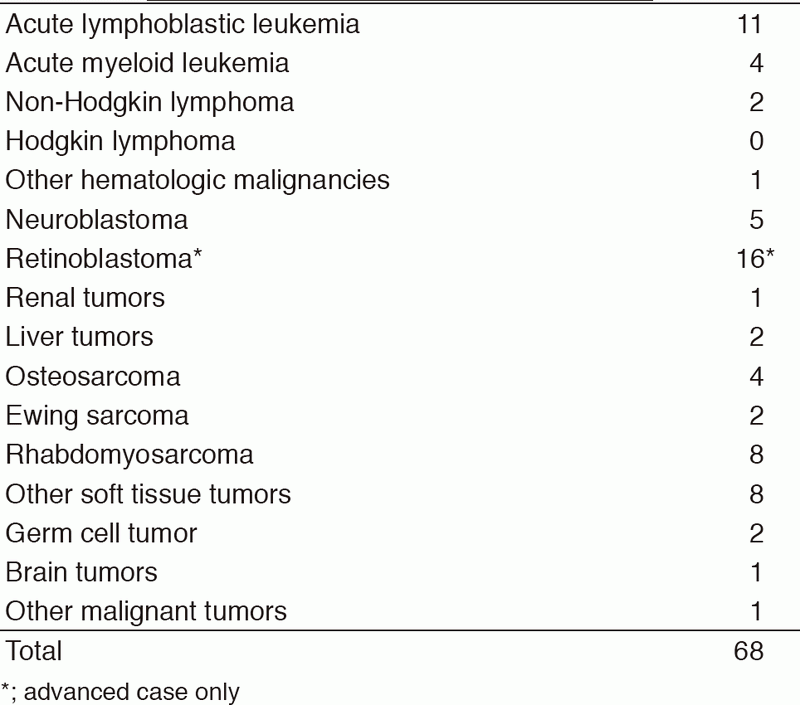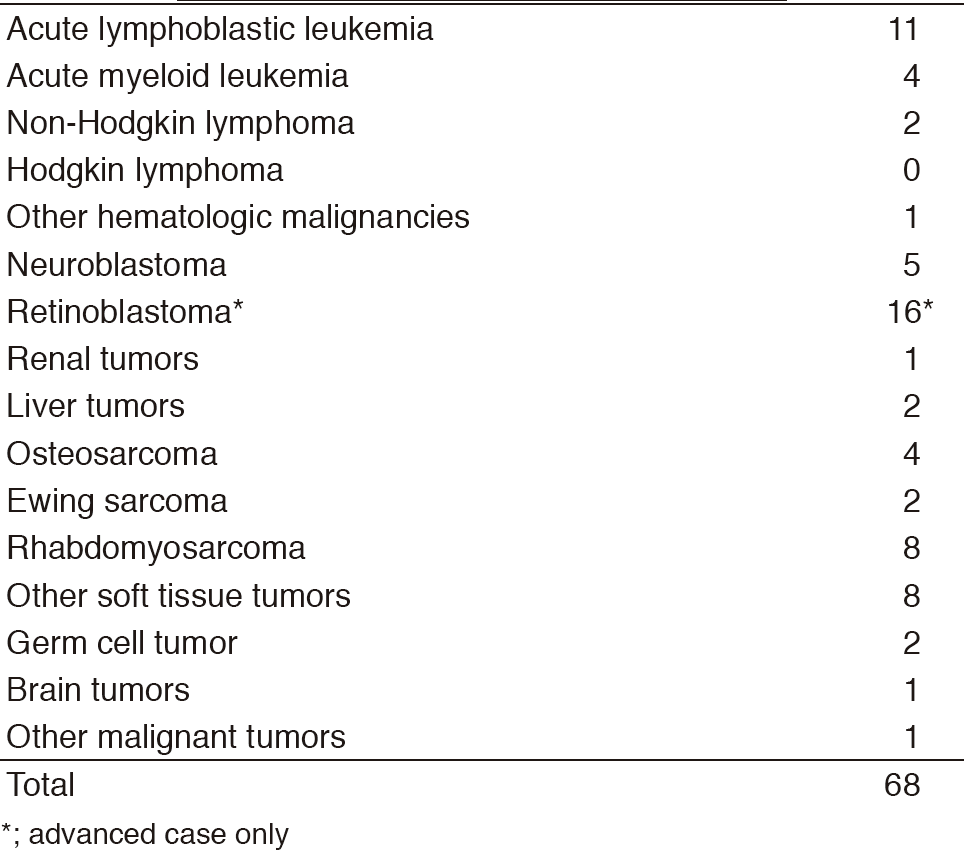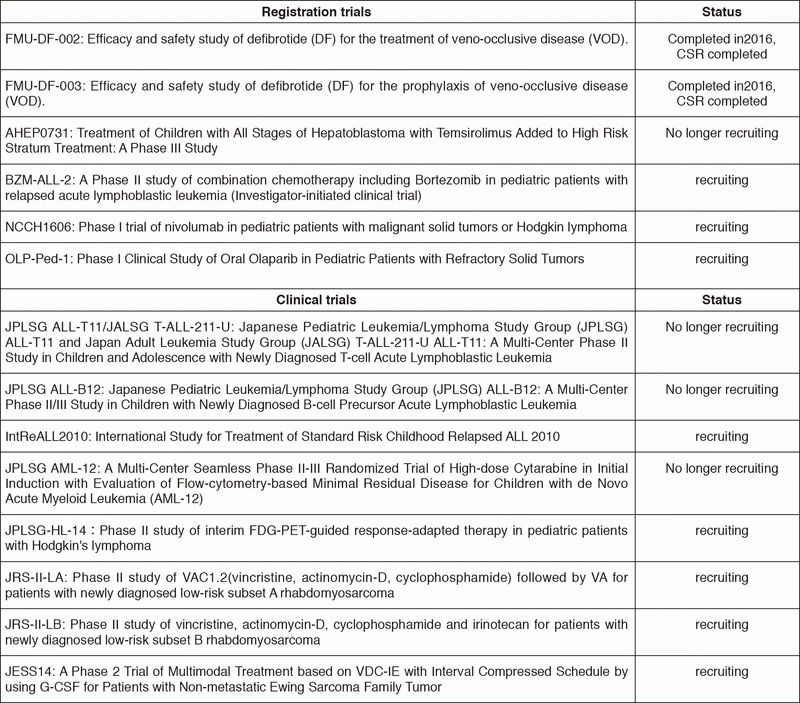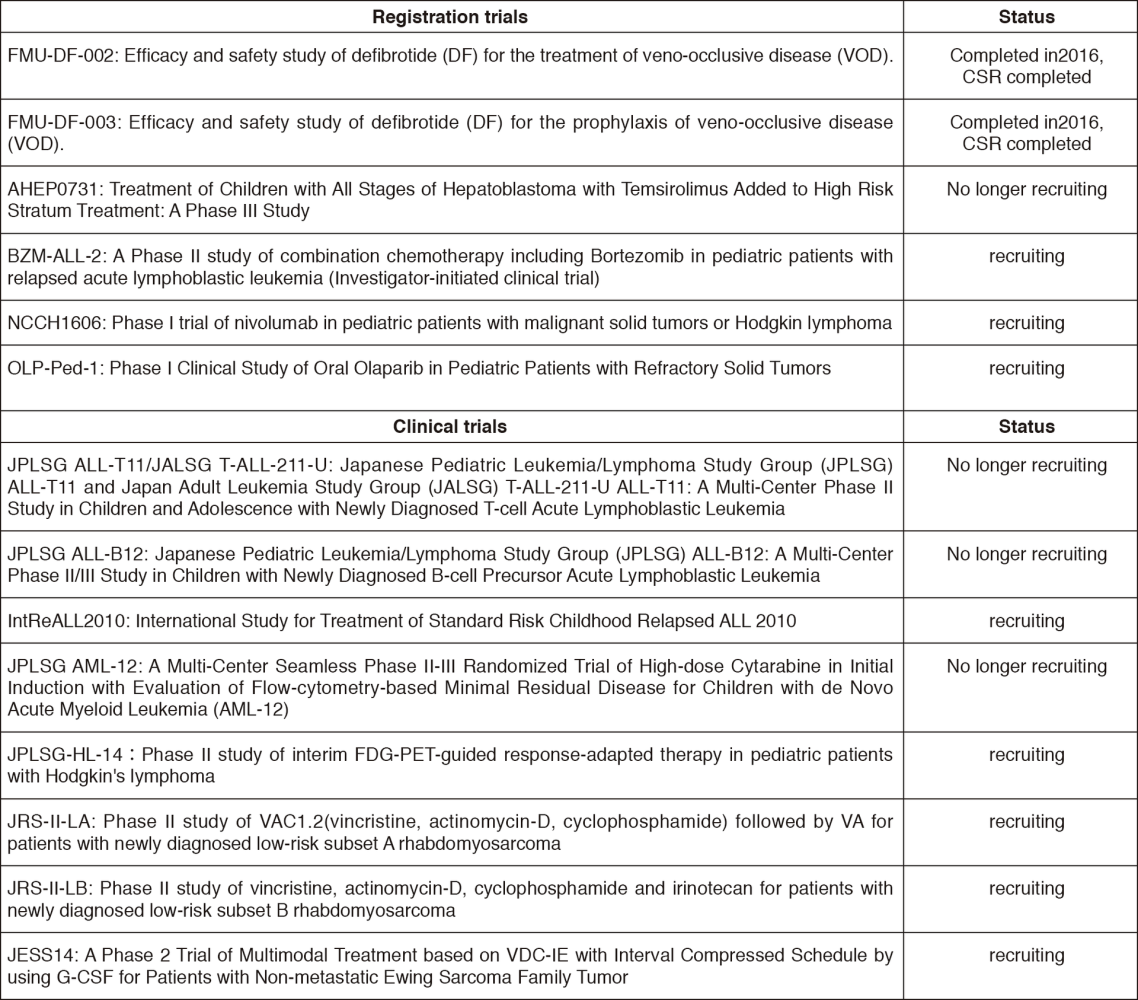Annual Report 2017
Department of Pediatric Oncology
Chitose Ogawa, Tadashi Kumamoto, Ayumu Arakawa, Masanaka Sugiyama, Tomoko Sonoda, Sae Ishimaru, Nami Shirakawa, Yuki Nogami
Introduction
Pediatric oncology includes a wide variety of malignancies in children and adolescents such as acute leukemias and malignant lymphomas, as well as solid tumors including osteosarcoma, soft tissue sarcomas, neuroblastoma, liver tumors and retinoblastoma. Many diseases are usually chemo-
sensitive and curable with appropriate treatment. The common approach to these diseases is a "risk-adapted therapy" strategy considering long-term life expectancy. In the Department of Pediatric Oncology, patients with pediatric malignancies are managed by four pediatric oncologists and a pediatric surgeon. Although pediatric oncologists mainly treat and manage patients, a multidisciplinary team approach including radiation oncologists, orthopedic surgeons, ophthalmologic surgeons and others is incorporated for the treatment. To achieve treatment completion and optimal quality of hospital life for children, pediatric nurse specialists, teachers, child care staff, psychologists and psychiatrists also join our team. For young patients, educational opportunities ranging from elementary school to high school are available in the pediatric ward, where seven teachers work daily.
Our team and what we do
We deal with 50-70 new patients every year. The number of patients is shown in Table 1. Our daily activities in the pediatric outpatient clinic are to manage new patients, to treat patients with chemotherapy or blood transfusions, and to provide follow-up care for patients who have completed intensive treatment. Patients receive multidisciplinary therapy, including surgical removal of the tumor, radiation therapy, chemotherapy, and sometimes Stem Cell Transplantation (SCT), as indicated.
A pediatric conference is held every morning, mainly to decide on individual treatment plans. The pediatric staff and trainees discuss various issues regarding pediatric inpatients on daily rounds. Inter-departmental conferences in cooperation with the Departments of Musculoskeletal Oncology and Rehabilitation, Radiation Oncology, and Palliative Medicine are individually scheduled for every two weeks.
Table 1. Number of patients in 2017

Research activities
1) For newly diagnosed patients, we participate in several multicenter studies in the Japan Children's Cancer Group (JCCG), including those by the Japan Ewing Sarcoma Study Group (JESS), the Japan Rhabdomyosarcoma Study Group (JRSG), and the Japanese Pediatric Leukemia/Lymphoma Study Group (JPLSG).
2) For relapsed patients, we are actively involved in the development of new drugs and treatments including off-label and unapproved medications.
3) For individualized treatment, we expanded the inclusion criterion in the TOP-GEAR Project, implementation of clinical sequencing, to children and started the recruitment of pediatric patients.
4) For provision of the similar environment during the treatment for that of before patients' disease onset, we plan to construct a medical care system through the use of appropriate medical and social resources in their local communities.
Clinical trials
In 2017, we conducted 12 clinical trials, including early phase trials, an international study, and cooperative studies. All clinical trials are listed in Table 2. The six trials, including two trials completed in 2016, are investigator-initiated
registration-directed clinical trials conducted under the Pharmaceutical Affairs Law in Japan. Clinical study reports (CSRs) were completed and provided to the pharmaceutical company for the application for approval in two completed trials. Two international cooperative trials are ongoing; IntReALL2010 and AHEP0731. In IntReALL2010, we are collaborating with the International BFM group in Europe, and in AHEP0731 with the Children's Oncology Group in the USA.
Education
We provide personnel training and education for skills of diagnosis and management for pediatric hematological malignancies and solid tumors. Residents also learn skills to treat not only newly diagnosed patients, but also relapsed or refractory patients by the global standard therapy. In addition, senior residents acquire abilities to plan studies for new agents or new therapies, which we regard as an important role of the National Cancer Center (NCC).
Future prospects
We promote the development of therapies for pediatric malignancies as a top priority. For this mission, we lead the plan for clinical or registration trials in cooperation with domestic and international centers as a core institution in Japan.
Our other mission is to provide individualized medicine for children with cancer. For this aim, we plan to expand subjects in the comprehensive genetic testing project in the NCC to pediatric age group. In addition, we promote clinical trials using molecular targeted agents for pediatric malignancies.


List of papers published in January 2017 - March 2018
Journal
1. Ogawa C, Taguchi F, Goto H, Koh K, Tomizawa D, Ohara A, Manabe A. Plasma asparaginase activity, asparagine concentration, and toxicity after administration of Erwinia asparaginase in children and young adults with acute lymphoblastic leukemia: Phase I/II clinical trial in Japan. Pediatr Blood Cancer, 64:2017
2. Katanoda K, Shibata A, Matsuda T, Hori M, Nakata K, Narita Y, Ogawa C, Munakata W, Kawai A, Nishimoto H. Childhood, adolescent and young adult cancer incidence in Japan in 2009-2011. Jpn J Clin Oncol, 47:762-771, 2017
3. Takagi M, Ishiwata Y, Aoki Y, Miyamoto S, Hoshino A, Matsumoto K, Nishimura A, Tanaka M, Yanagimachi M, Mitsuiki N, Imai K, Kanegane H, Kajiwara M, Takikawa K, Mae T, Tomita O, Fujimura J, Yasuhara M, Tomizawa D, Mizutani S, Morio T. HLA haploidentical hematopoietic cell transplantation using clofarabine and busulfan for refractory pediatric hematological malignancy. Int J Hematol, 105:686-691, 2017
